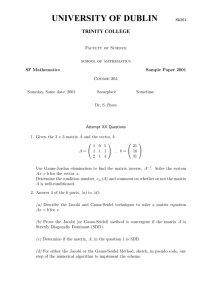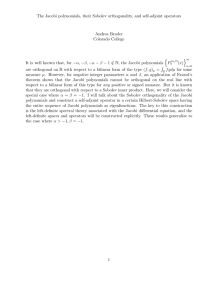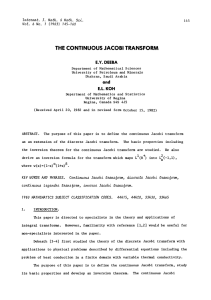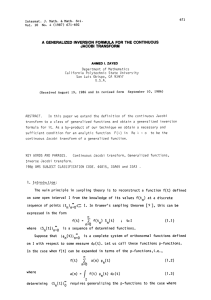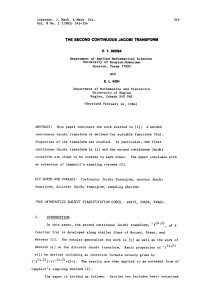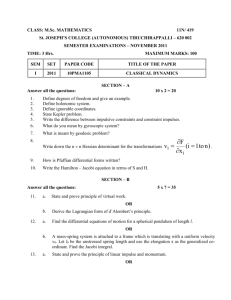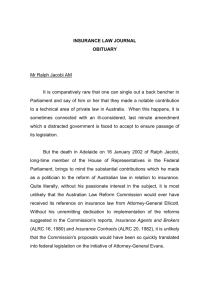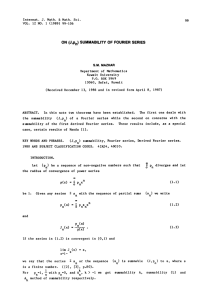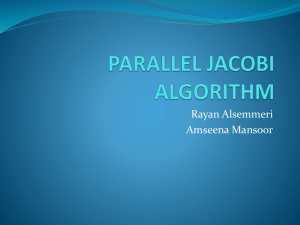REPRESENTATION FUNCTIONS
advertisement
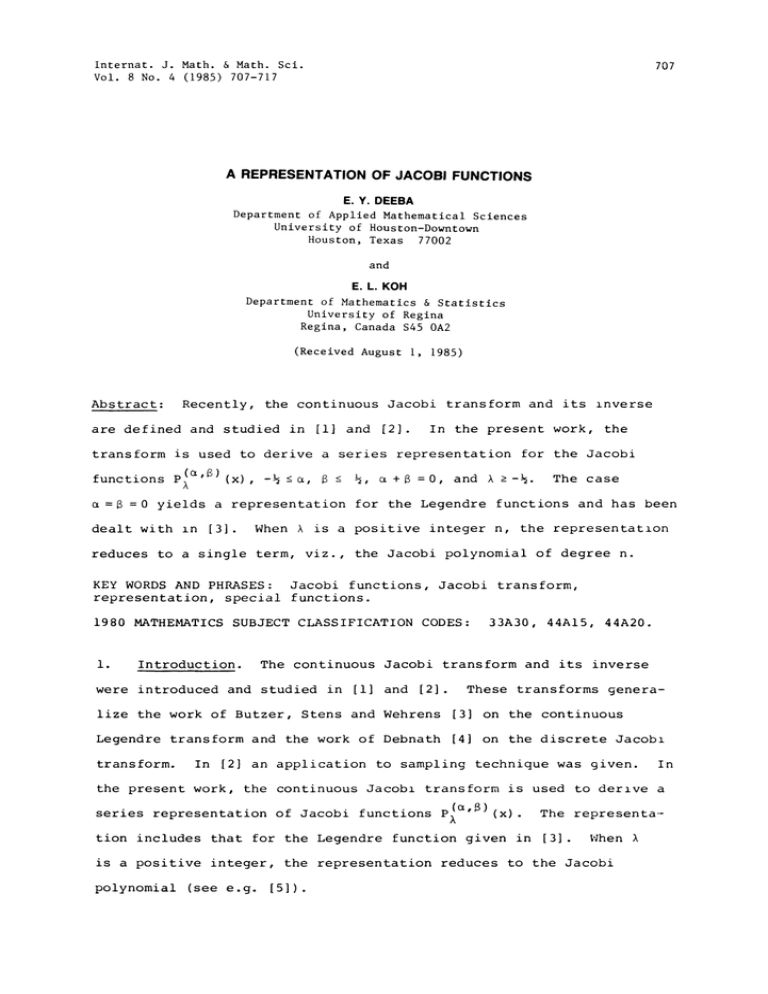
Internat. J. Math. & Math. Sci.
Vol. 8 No. 4 (1985) 707-717
707
A REPRESENTATION OF JACOBI FUNCTIONS
E. Y. DEEBA
Department of Applied Mathematical Sciences
University of Houston-Downtown
Houston, Texas 77002
and
E. L. KOH
Department of Mathematics & Statistics
University of Regina
Regina, Canada $45 0A2
(Received August i, 1985)
Recently, the continuous Jacobi transform and its
Abstract:
are defined and studied in [i] and [2].
inverse
In the present work, the
transform is used to derive a series representation for the Jacobi
functions
e
=
Pe’) (x)
-% <e,
1/2, e
+
=0, and I ->-1/2.
The case
=0 yields a representation for the Legendre functions and has been
dealt with zn [3].
When I is a positive integer n, the representation
reduces to a single term, viz., the Jacobi polynomial of degree n.
KEY WORDS AND PHRASES: Jacobi functions, Jacobi transform,
representation, special functions.
1980 MATHEmaTICS SUBJECT CLASSIFICATION CODES:
i.
Introduction.
33A30, 44A15, 44A20.
The continuous Jacobi transform and its inverse
were introduced and studied in [i] and [2]
lize the work of Butzer, Stens and Wehrens
These transforms genera-
[3] on the continuous
Legendre transform and the work of Debnath [4] on the discrete Jacobl
transform.
In [2] an application to sampling technique was given.
In
the present work, the continuous Jacobl transform is used to derzve a
series representation of Jacobi functions
P’)(x).
The representa-
tion includes that for the Legendre function given in [3].
When 1
is a positive integer, the representation reduces to the Jacobi
polynomial (see e.g.
[5])
708
2.
E.Y. DEEBA AND E.L. KOH
Preliminaries.
In this section we review material needed in the
development of the paper.
For e, B >-i, I eR, I +e +8 0,-I,-2
(e,8) (x)
function of the first kind,
P1
p e,8) (x)
F (l+e+l)
=F(I+I)F(e+I)
and x e (-i,i], the Jacobi
is given by
F(-1,1+e+8+l;
e+l;
lx
(2.1)
(see [6]) where
(a)k(b)k
k=O[
F(a,b;c;z)
k
Izl
I,
a,b,c real numbers with c 0,-i,-2,
(,8)
F(-I+I)F(I--8)
Since
(x)
p(
,’Ckk’.
Pl
z
e+8+12
restrict ourselves to i>_
d
d
(I -x 2 )P
p ,8) (i)
e
)
F (I++i)
F(I+I)F(e+I)
and
(l-x
2)d P e,8) (x)
l(a-B)
(21+e+8
Ix)
+ 2(l+e) (I+8)
21+e+8
For a proof of (2.2),
_
(x)) =-I(I++8+i)
pe
(1-x)
e(l+x) 8
w(x)P ’) (x)
8)
(x).
(2.4)
The term w(x)
in (2.2)
and will be used throughout
Furthermore, it was shown in [i] that for I a
the paper.
(2.2)
(x)
(2.3) and (2.4) see [i].
is the weight function w(x)
satisfies the
(2.3)
(e,8)
P1
we may
pe,8)(x)
The function
following relations:
d--(w(x)
8)
I--8-i (x)
F(I-A)F(I-8)
+8+I
and
2
for any x e (-i,I].
<
where M(I,,B)
F(I++I)
+M(I e 8)log
F (I+1) F (e+l)
2
(2 5)
is some constant depending upon I, e and 8;
+S+l
any I, >-
u,
-(u++8+l)
and for
e >-1/2, -1/2 <8 < 1/2 we have the
relation
1
2 e+B+l
i
J-i
w(x)
( 8)
PI
(x)P(8’) (-x)dx
F (l+c,+l) F (+8+I)
F(l-Sil+v+e+B+l)
sin I
r (u+l) F (l+(,+B+l)
(2.6)
sin
(I+1) r (u+e+8+l)
REPRESENTATION OF JACOBI FUNCTIONS
709
We shall denote, throughout, the weighted square integrable
Lw2(-l,l)
functions on (-I,i) by
2(-I,I)
For f e L
> -%, -1/2
w
the continuous Jacobi transform (see [i]) is defined by
(,B)
=
When
1
1
(I)
w(x)p ,B) (x)f(x)dx
2+8+i -i
(,8) reduces
=0,
1/2,
8
(2.7)
to the continuous Legendre transform
studied in [3] and whe, l=n e P (P, the set of non-negative integers),
reduces to the discrete Jacobi transform of Debnath [4].
It was shown in [i] that if
11/2f (e’8) (I-1/2)eLI(R +)
and if
e+8 =0
then for almost every x e (-i,i), we obtain the inversion formula
f(x)
(e,S)
4
(I-!)
0
where
p(e,8) (-x)H0 (I) IsinIdl
I-%
(2.8)
2
F (I+1/2)
F (I++1/2) F (I+8+1/2)
H ()
0
_
Since we needed the condition
+8 =0 to derive (2.8), we shall,
from now on, assume this condition on
and 8.
In [2] the second continuous Jacobi transform was studied.
-+1/2
f6LI(R+),
it is given by
(-x)
F(I1/2)
F (++1/2) Isinldl
For
(2.9)
and the associated inversion formula is
f(1)
1/2
[
F(I++1/2)
F(I+1/2)
1
w(x) P
-i
e 8)
(x) f
(e 8)
(x)dx
The relation between the different transforms
(^f(,8) (.))^(e,8)
(I)
(2.10)
(see [2]) is
2F(l+e+1/2) f(1)
F (I+1/2)
and
(+1/2)
(F (l+e+1/2) (
8)
(’))
( S)
(x)
f(x)
As an application of (2.9) and (2.10), it was shown in [2] that
if FC(R
+)
is given by
1
F(1)
-i
w(x)f(x)P((X’8)
I-1/2
(x)dx
710
E.Y. DEEBA AND E.L. KOH
for some U
feL2w(-l,l),
0,
+,
we have
(2n+l)F(n+l)F(l+e+1/2)sinn(l-(n+1/2))
n[0
F(1)
then for all leR
(A2
2
2
-(n+1/2) )F(n++I)F(I+1/2)
We will employ (2.7),
(2.8),
’)(x)
(,_)
as
Pl
Since e + 8
e+
section we shall assume
0, -1/2
0,
(x).
Again, throughout this
Derivation of the Representation Formula.
3.
(2.11)
(2.9) and (2.10) to derive the
representation formula of the Jacobi functions.
we shall write P
n+1/2
F(---)
1/2 and
e, 8
, 0.
The case
=0
reduces to the representation of the Legendre functions and has been
developed in [3].
The series representation that we will develop, in this section,
for P
(,-)
’
P
(x)
)
is
sinl
F (A+I)
F(A+I)F(+I)
(x)
(2n+l)n!
I (I+i)
n(n+l) (+i)
n=l
I(+I)
(-l)np n(e’-e)
(-i)
[
n=0
n
e+n+ 1
n(-n)
l-x n+ 1
(i--/)
(x)
(A+n+l) + i
},
0 -<x
i,
(3.1)
and
(’-e)
Pl
F(A++I)
F(A+I)F(+I)
(x)
sinl
(-l)np(e’-)
(x)
n
(+I) n(A-n) (A+n+l)
(2n+l)n!
{X(A+I)n=I
i+
l+x,
n(n+l)
e
(-l)n
(_--/i7+/-_^ sinn------ +
e-n-I
n=0
+i +
I (l+l)
,l+x,n+l
(---/’
-i
x -< O.
(3.2)
In order to derive (3.1) and (3.2), we shall first introduce an
auxillary function k(x;h), apply (2.7),
(2.9) to k(x;h) and utilize
the uniqueness of the Jacobi transform.
Lemma 3. i.
For he(-l,l)
i
define
[(l+x.
e
l+h,
h_<x<l,
k(x;h)
-l<x-<h
Then
REPRESENTATION OF JACOBI FUNCTIONS
(’-)
-
(x;h) (1)
--2e
Proof.
(2.2)
[(e,-e)
1
p,-e) (h)},
F(l+e+l)
1
l(l+l)
(l+h,
h
711
I l-x
[ h( l--)dx}’
I0, la-1/2
I=0.
together with (2.7) yields for 1,0 and e+8 =0
I
(-;h)(I) =1/2
e(l+x)
(l-x)
J-i
(l-x)
1/21(l+l)
pe,-e) (x)k(x;h)dx
d
(l+x)
d-
-I
P
e
(x))k(x;h)dx.
On integrating by parts, we obtain
(e,-e)
(. ;h) (I)
p e,-s) (x)dx
l(l+l)
h
I >-1/2
from which it follows that for l0,
(e,
e)
1
l(---{P
(. ;h) (I)
-e)
(1)-P
e
-)
(h)
Equivalently,
{(a,-e)
(. ;h) (1)
e
-)
1
I(I+1)
(l+e+l)
F(I+I)F(+I)
(x)=i
This together with (2.7) yields
P
(h)
from (2.3)
When I
(e,-a)
0,
(’-)
P0
=1/2I (l-x)e(l+x)-ek(x;h)dx
(-;h)(0)
1
i
:1/2
(l-x)
Jh
l+x, e
l+h, e
e(l+x)-e{[1 im-{;
-i:;" ]]dx
l+h,
1
=2-- [1-h-(;
1
I (l-x)
h
lx dx].
This completes the proof of Lemma 3.1.
Since
on
(-i,i)
k(x;h)
11/2k (’-) (’,h)(I-1/2)LI(R+)
it follows from (2.8)
=4[
1
0
12-%
and since k(x;h)
is continuous
and Lemma 3.1 that for I
F(I+1/2)
F (l-e+1/2) F (e+l)
0
-_ (h) ).
2(l+1/2)Pei-e)’
-Y(X+’e+1/2)F (X"a+1/2)
F
(-e,c) (-x)IsinIdl.
Pl-1/2
From (2.11) with
=i, o -> 0, h6 (-i,I)
(3.3)
and Lemma 3.1, we have
712
E.Y. DEEBA AND E.L. KOH
k
(a,-a)
(-.h) (o-1/2)
=o"2-
r(o+1/2)r(a+1/2)
r (o+a+1/2) (a’-) (" ;h) (0) sin (o-1/2)
2
(o -1/4) r (o+1/2) r (e+l)
+
n=l
+
(2n+l) r (n+l) r (o+a+1/2) sin (o-n-1/2)
1
2
2
n (n+l)
(o -(n+1/2) )r(n+e+l)r(o+1/2)
[r(n+e+l)
[_r (e +i) n.’
_p(e,-e) (xI
n
(e,-e) (- ;h) (0) is as
given in Lemma 3.1.
where
Replacing o by
X+1/2
in the above expression together with Lemma 3.1 and the uniqueness of
the Jacobi transform imply
1
i(I+1)
V r (X+e+l)
[re+l)r(1+1)
(e,-e)
PI
(h)]
r(1+e+l)sinnl k (e,-e) (x;h)(0)
(I) (I+1) r (a+l) r (I+1)
r (n+l) r (1+e+l) sin (l-n)
1
(l-n)
w
(1+n+l) r (n+e+l) F (I,1)
n (n+l)
n=l
(n+e+l)
[ rr (e+l)
n.’
+ v/ (2n+l)
p(e,-e) (x)j
n
Therefore,
p e,
r (1+e+l)
e)(h)=r(e+l)r(1+l)
I(+i)
[ (1-n)
n=l
+
r(l+e+l)sinw1
r (e+l)
(e’-e)
r (I-1)
(.,h) (0)
(2n+l)r (1+e+l)sinn(1-n)
(1+n+l)r(1+l)n(n+l)r(e+l)
I(I+1) (2n+l)n’.r(1+e+l)sin(1-n)P (a’-e) (h)
n
(l-n) (1+n+l) r (n+e+l) r (1+l)n(n+l)
n=l
From (2.7) we now have
Pi
e’-a)
(0)
1/2
(l-x)
(l+x)
J-i
-
(x)P
0
(3.4)
(x)dx
which together with the above expression for P ’-) (h)
yields
1
-i
r (1+e+l) sinl (e’-e)
r (+l) r (l+l)
a+l)r(+l)
(x,h) (0)
(2n+l) I (l+l) r (l+o+l)sin (l-n)
(-n) (l+n+l) r (I+i) n (n+l) r ((+i)
p(,-e) (x)
(2n+l) I (l+l) r (l+o+l) sinn (l-n)
,(-n) (l+n+l)r (n+e+l)r (l+l)n(2n+l)
dx
REPRESENTATION OF JACOBI FUNCTIONS
713
Using Euler’s formula [5]
x
(x-t)
t
F(e+l) F(B+I)
F (+8-2)
dt
0
+8
with
O, t
x+B+l
8 >-i
(3.5)
1 +u, we obtain
i
(l-x)
(l+x)
dx
2F(e+l)F(1-s)
J-i
This together with Lemma 3.1 yields
r (i-) r (l+e+l)
(0)
n= I
r(>+l)
(l+l) (2n+l) F (i-) F (l++l) sinn (A-n)
n (n+l)n (l-n)(l+n+l) F (I+i)
F(l+e+l)sinnl
2F (e+l) F (+i)
Ii
+ F (I++i) sinl
2F (+i) F (I+i)
fl
(l-x)
(l+x)
-e
-i
(l_x)
a
(l+x)
-i
-
(l-x) dx
(l+x)
2
(l_x) -a
[i
l-t
Jx (i-6)
ad t
I (I+i) (2n+l) n F (I++I) sinn (l+n)
g
n=l (l-n) (l+n+l) F(n++l)F(l+l)n(n+l)
+
1/2
-i
(1-x)a(l+x)-a p(’-a)
n
(x) dx.
The last term in the above expression vanishes by the orthogonality
of the Jacobi polynomials;
iI
(1-x)e(l+x)
-i
I
1
-
P(’-)
n
(-x)(+x)
-i
using (3.5)
1oreover,
(l-x)
that is,
-
(x)dx
’-)(x)P n(’-) (x)dx
o
the third term can be written
(l+x)dx
F(+2)F(I-).
The re fore,
^
P
-)
(0)
r(l-) r(l++l)
P(-I+I)
l(l+l) (2n+l) F(I-) F(l+e+l)sin(l-n)
n(n+l)(l-n) (l+n+l) F(l+l)
_F (I++i) sinnl
2F (’I+i) F (+i) e F(+2) F(I-) +
F(l++l)sinl
4F(l+l)F(c+l)a
!i Ii (-$-)
l-t e
-1 x
dtdx.
(3.6)
dx
714
E.Y. DEEBA AND E.L. KOH
(2.7) and the identity p (’8) (-x)
n
From (2.6)
it follows that
(-I) n p (S ,a) (x)
n
(3.7)
Hence by the uniqueness of the
Jacobi transform, we have from
(3.6)
and (3.7)
k(l+l) (2n+l)sin (h-n)
n (n+l) n (l-n) (k+n+l)
+
Ii Iix(-) ad
sin
l_t
4-aF (l+a) F (i-)
sin X
t
-I
Now (3.4) can be expressed as
F(k+l)X(a+l) p(e,-e)
(x)
F (l+a+l)
(2n+l) n sin (l-n) P ((,--) (x)
X (k+l) [ n(n+l) (e+l) (l-n) n
(l+n+l)
n=l
n
1
+ sinnl |
1
!+
(l_t)
4F (u+l)
(l+t)
-edtdx
r (l-e)
a l+x)a[l (i-) :.
x
l-t e
+h-+
1--
dt
x
By interchanging the order of integration and by (3.5) we obtain
1
1
(l+t)-edtdx
2r(l+a)F(2-e)
Thu s,
P(l+l)F(e+l)
F (l+a+l)
p(,-e)
[
n=l
+ sinl
n
(e-e)
sinIP
(x)
n
(kn) (l+n+l)
n(n+l) (e+l)
n
(2n+l)n’
) (l+l)
(x)
I)
1
I
1 +k(l+l)
2a
-
1
+x + _i
l+x.f
T$-) dt;.:
zj(T x (l-t
The series representation of the Jacobi function
Pe’-e)(x)
(3.8)
will be
completed once we obtain an equivalent expression for the integral.
i
f(x;)
Lemma 3.2.
l-t) ed t
x (i
For
-%
a
%, (a
0)
we have
REPRESENTATION OF JACOBI FUNCTIONS
+i
(l-x)
f (x;)
a)
(l+x)
f (x;e)
b)
Proof:
a)
2e
l+x
a
n=l
e
(l-x)
2e
sine
-i
(l+x)
2
l-x
(i
n
.l-x) n)
+n+l[l--x
(-i)
715
(-l)n
[
n=l
e-n-i
0 -<x
l+x.n
(-C;
1
-i
x
0
Integration by parts yields the recursive relation
f (x;e)
1
(l-x) e+l
e
e+l
(l+x)
e
f (x; +i)
:.+i
By employing this relation and after simplification, we obtain
f(x;)
(1-x)+l (I
(l+x)
2e
I+
e
n=0’"
(-l)n 1-x)n
(i--
n+e+l
The series converges for all x such that
0
< i;
that is, if
When x =0,
x < i.
f(0;e)
b)
l-x
l--x
l-2e
(_l)n
[
n++l"
n=0
We rewrite f(x;
f (x;)
I
as
0
l_t) ed t +
(x
I
I l-t e
(-) dt
J(x;e) + f(0,e), say.
0
5y introducing
x
J* (x;e)
l-t
J-I (-)
ed t
J(x;) can be written as
J(x;e)
J*(0;) -J*(x;e).
Upon an integration by parts, we obtain
J*(x;e)
1
(l-x)
I---- (l+x)-I
+
J*(x;e-l)
Repeating the above formula, recursively, results in the series.
J*(x;)
(l-x)
(l+x)-I
(i
2e
l-x
[
n=0
which converges for all x such that
When x
0,
J*(0;e)
1
(-I)
2e
n=O
n
e-n-I
(-l)n .l+x,n)
[;
s-n-I
l+x
II
< i;
that is, for-i < x < 0.
716
E.Y. DEEBA AND E.L. KOH
Th us,
f(x;)
J*(0,e) + f(0,) -J*(x;)
(l-x) e
(i
(l+x) -I
2e
sinne
2e
I----
(-i) n
l+x.n
n=0[’ --------n-i
(I--)
which completes the verification of Lemma 3.2.
From (3.8) and Lemma 3.2, the representation of the Jacobi
P’-e)(x)
function
p e, e) (x)
?,
nll
n=0
In particular, for I _-1/2 (l
0)
F(l+e+l)
sinl
{l(l+l)
F(I+I)F(+I)
(2n+l) n.’
n(n+l)
will follow.
(-l)np n(e’-)
(e+l)n(l-n)
(-l)n l-x) n+ 1 }’
l--/x
n++l
(x)
(l+n+l) +I+
I (l+l)
0-<x<l;
and
P e’-e) (x)
(2n+l)n.’
F (l+e+l)
sinl {I
(I+I)F(I+I)F(+I)
(-l)np (’-e)
n
[ (n+l)(+i) (l-n)
n=l
n
(x)
1
+ 1 +------(l+n+l)
l(l+l)
,
n
(-i)
.l+x. n+l
+ (l+x) e
+
-C;
e-n-I
sin
l-x)
’J^=u
n
1
+
-I< x <0
The above representations will hold for I =0 provided that
sinl
is interpreted to be equal to 1 for I =0.
When e =0, the
formula reduces to that for Legendre functions derived in [3],
1
(l+x)
n
provided that+
is given its limiting value of 0 as
sin
(l-x)
+0.
REFERENCES
[i]
Deeba, E.Y. and E.L. Koh, The continuous Jacobi transform,
Internat. J. Math and Math. Sci. Vol. 6, No. 1 (1983), 145-160.
[2]
Deeba, E.Y. and E.L. Koh, The second continuous Jacobi transform,
Internat. J. Math and Math Sci.
[3]
(to appear).
Butzer, P.L., R.L. Stens and M. Wehrens, The continuous Legendre
transform, its inverse transform and applications, Internat. J.
Math and Math Sc. Vol. 3, No. 1 (1980), 47-67.
REPRESENTATION OF JACOBI FUNCTIONS
[4]
Debnath, L., On Jacobi transform, Bull. Calc. Math. Soc., Vol.
55 (1963)
[5]
717
113-120.
Luke, Y.L., The Special Functions and Their Applications, Vol. X,
Academic Press, New York, 1969.
[6]
Erdelyi, A., W. Magnus, F. Oberhettinger and F.G. Tricomi,
Higher Transcendental Functions, Vol. I, McGraw Hill, New York,
1953.
